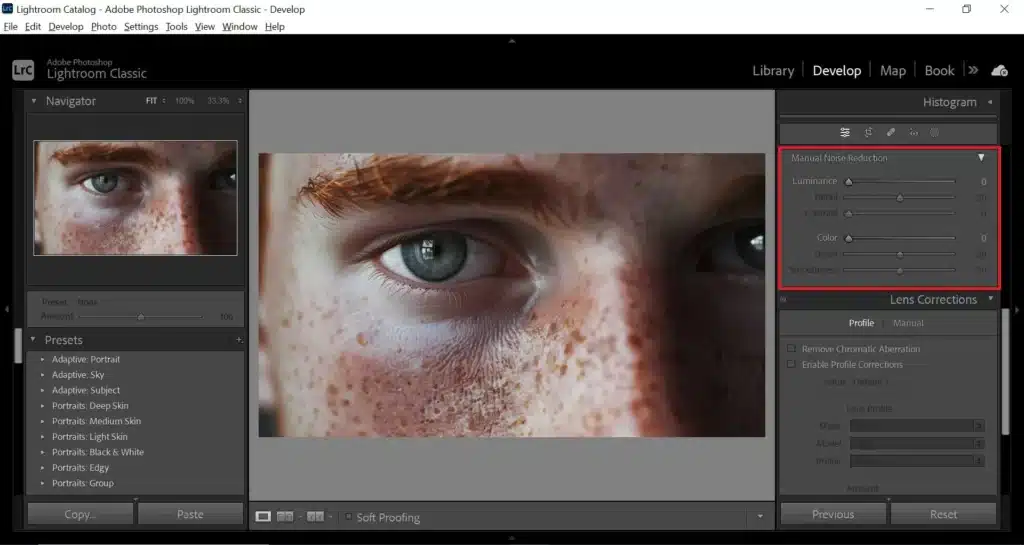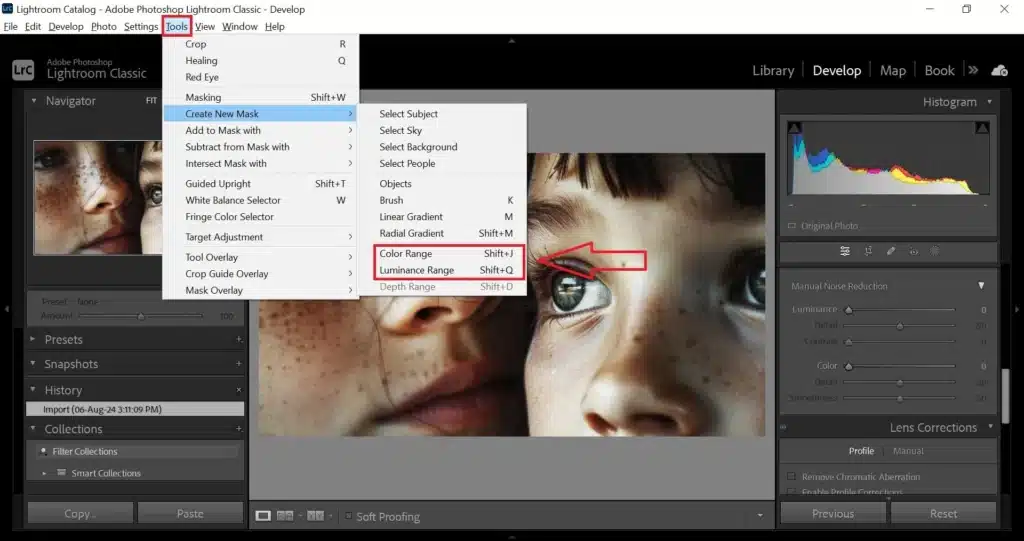
Introduction to How to Fix Grainy Photos in Lightroom
Table of Contents
Understanding and Causes of How to Make a Photo Grid in Lightroom

What is Grain in Photos?
Grain, also known as noise, refers to the random variations of brightness or tone information in snapshots. Using different digital cameras, this appears as a speckled or textured look, particularly noticeable in the darker areas of a photo. While some photographers may use grain for artistic effect, it is generally considered undesirable when it distracts from the image’s clarity and detail.
Causes of Grain in How to Fix Grainy Photos in Lightroom
High ISO Settings
One of the primary causes of grain in photos is the use of high ISO settings. ISO controls the camera sensor’s sensitivity to light; higher ISO settings are often used in low-light conditions to brighten the portrait. However, increasing the ISO also amplifies the sensor’s electrical signal, which can introduce more noise. For instance, shooting indoors or at night without sufficient lighting often necessitates a higher ISO, leading to grainier portraits.
Low Light Conditions
Grain can also be caused by shooting in low light photography conditions. When there isn’t enough light available, the camera struggles to capture a clear snapshot, resulting in more noise. This is because the camera sensor tries to compensate for the lack of light by boosting the signal, which introduces noise. An example of this is photographing a dimly lit concert, where even with a moderate ISO, grain can be prevalent due to the challenging lighting environment.
Underexposure
Underexposing portraits is another common cause of grain. When snapshots are underexposed, they appear darker and may lack detail. Correcting this by increasing the exposure in post-processing can introduce significant noise. For instance, if you take a picture in a shadowy area and later try to brighten it in Lightroom, the underexposed areas may reveal more grain as the software amplifies the noise along with the light.
Step-by-Step Guide to How to Fix Grainy Photos in Lightroom
1st Step: Import and Prepare Your Photo
- Importing RAW Files: Start by importing your RAW format files into Lightroom. Using RAW files is crucial as they contain more snapshot data compared to JPEGs, giving you greater flexibility in editing. This allows Lightroom Classic to better translate adjustments without degrading image quality.
- Preparing the Develop Module: Once your images are imported, head to the Develop module. Here, you can search for the Detail panel, where all the noise reduction tools are located. Make sure your snapshot is zoomed in at 1:1 ratio to get an accurate view of the graininess.
2nd Step: Identify the Type of Noise
- Luminance Noise: Luminance noise appears as grainy textures across the image. To tackle this, locate the Luminance slider/option under the Noise Reduction section. Moving this option to the right reduces the grain, but be cautious not to overdo it as it can soften details.
- Color Noise: Color noise, on the other hand, appears as random color temperature. We can call the color noise as tone noise also. Use the tone option in the Noise Reduction section to reduce this type of noise. Just like with luminance noise, balance is key to avoid making the image look unnatural.
3rd Step: Adjusting the Noise Reduction Settings
- Fine-Tuning with Detail and Contrast Sliders: The Detail and Contrast options under the Luminance section help retain some of the original textures and edges while reducing grain. Increasing the Detail slider will keep more textures, while the Contrast option can help maintain tonal contrast within the snapshot.
- Balancing with Tone Detail and Smoothness: For color noise, the Detail and Smoothness sliders allow for fine adjustments to get the smooth skin. The Detail option preserves color details, and the Smoothness option helps in blending the color corrections seamlessly, providing a natural look to the image.
4th Step: Apply Final Touches
- Using Presets for Consistency: If you frequently deal with grainy portraits, consider creating or downloading noise reduction presets. These Lightroom presets can save time and ensure consistent results across your photo collections.
- Review and Export: After applying noise reduction, review the image at different zoom levels to ensure that the grain is minimized without losing essential details. When satisfied, export the snapshot using appropriate options for its intended use, whether for web posting or print.
Table: Noise Reduction Overview Related to How to Fix Grainy Photos in Lightroom
| Setting | Purpose | Recommended Value | Impact |
|---|---|---|---|
| Luminance Slider | Reduces overall grain | 20-40 | Smooths portrait but may soften details |
| Detail Slider | Retains texture and details | 50-70 | Keeps textures while reducing grain |
| Contrast Slider | Maintains tonal contrast | 10-30 | Enhances contrast without adding noise |
| Color Slider | Reduces color noise | 25-50 | Neutralizes random color pixels |
| Color Detail Slider | Preserves color details | 50-70 | Balances color correction |
| Color Smoothness Slider | Blends color corrections seamlessly | 50-70 | Provides natural look to color noise |
How to Fix Grainy Photos in Lightroom: Avoid Common Mistakes
Overusing Noise Reduction Tools
One of the most common photo editing mistake when trying to fix grainy portraits in Lightroom is overusing noise reduction tools. While it can be tempting to slide the noise reduction options to their maximum to achieve a smooth look, this often results in a loss of detail and a plasticky appearance. It is important to follow Lightroom’s guidelines and apply noise reduction incrementally. Always double-check your results to ensure that details are preserved and that the portrait still looks natural.
Ignoring the Type of Noise
Another mistake is not identifying the type of noise present in your photo. Luminance noise and tone noise require different approaches. Many users make the error of applying a general noise reduction without considering these specifics, leading to suboptimal results. According to guidelines from professional photographers, it is essential to distinguish between luminance and tone noise before making adjustments. This way, you can apply the appropriate options and achieve a cleaner portrait.
Failing to Use a Clipboard for Settings
When working on multiple portraits, it’s helpful to use the clipboard feature to copy options the different image file types and apply them to others. Many users overlook this feature and manually adjust each photo, which can lead to inconsistencies and added work. By using the clipboard, you can ensure that all images receive the same treatment, saving time and maintaining a uniform look across your photo set.
Creating Duplicates Instead of Virtual Copies
Creating duplicates of your photos instead of using virtual copies is another common mistake. Duplicates take up additional storage space and can clutter your library, making it harder to manage your files. Lightroom allows you to create virtual copies, which are lightweight and do not consume extra storage. This approach is more efficient and keeps your workspace organized. Always be respectful of your storage limits and opt for virtual copies whenever possible. By using virtual copies, you ensure that your original files are preserved while you experiment with different edits.
Not Giving Credit to Original Settings
When collaborating with others or following tutorials, it is important to give credit to the original settings or techniques you are using. This not only shows respectful acknowledgment but also helps you keep track of what adjustments were made and by whom. Failing to give credit can lead to confusion and make it harder to reproduce or adjust the edits later. Always keep a copy of the original settings and ensure that any copied techniques are properly credited.
Not Seeking Upvote on Forums
Lastly, engaging with the Lightroom community and seeking upvotes on forums can provide valuable feedback and improve your photo editing skills. Many photographers miss out on this resource, limiting their growth and missing opportunities to learn from others. By posting your work and asking for upvote and critiques, you can gain insights and tips that can enhance your noise reduction techniques and overall editing process. Make sure to copy your most successful edits and share them with the community, and always acknowledge when you have copied advice or techniques from others.
Advanced Tips for Professional Results About How to Fix Grainy Photos in Lightroom
1. Using Selective Noise Reduction
Selective noise reduction is a powerful technique that allows you to apply noise reduction only to specific areas of your photo. This method helps in maintaining the overall sharpness of the image while reducing grain in problem areas. To do this, use the Adjustment Brush in Lightroom. Carefully paint over the areas with the most noise and apply the noise reduction options. This way, you can preserve details in sharper areas while minimizing grain where it’s most needed.
2. Combining Lightroom (Lr) and Photoshop (PS)
For the best results, consider using both Lr and PS. Start by reducing the noise in Lightroom, then transfer your image to PS for further refinement. PS offers advanced noise reduction filters types and tools that can help you fine-tune the details. To move your photo from Lr to PS, simply right-click on the image and select “Edit In” followed by “Adobe Photoshop”. Once done, you can link back the edited image to Lightroom for final adjustments.
3. Utilizing Sharpening Techniques
After noise reduction, images can often appear too soft. Applying sharpening can help bring back some of the lost details. In Lightroom, navigate to the Detail panel and use the Sharpening sliders. Be cautious not to over-sharpen, as this can reintroduce noise. A good practice is to increase the Sharpening Amount slider while holding the Alt key to see the effects in black and white, which helps in making more precise adjustments.
4. Leveraging External Plugins
There are various external plugins available that can enhance Lightroom’s noise reduction capabilities. Plugins like Topaz DeNoise AI and Nik Collection can provide more advanced algorithms for noise reduction. These plugins often offer trial versions, so you can experiment with them to see which one best suits your needs. Remember to always report your findings and share your experiences on forums or review sites to help others make informed decisions.
5. Maintaining a High-Standard Source
Always start with a high-standard source image. Shooting in RAW format ensures you capture the maximum amount of data, which provides greater flexibility in post-processing. Additionally, using a tripod and proper lighting techniques can minimize the need for high ISO sensitivity, reducing the amount of noise introduced in the first place. Ensure your camera settings are optimized for the environment you are shooting in to maintain a clean source image.
Table: Advanced Settings about How to Fix Grainy Photos in Lightroom
| Technique | Tool/Software | Benefit |
|---|---|---|
| Selective Noise Reduction | Lightroom Adjustment Brush | Targets specific noisy areas |
| Combined Editing | Lightroom & Photoshop | Advanced control over noise |
| Sharpening After Reduction | Lightroom Sharpening Sliders | Recovers lost details post-noise |
| External Plugins | Topaz DeNoise AI, Nik Collection | Advanced algorithms for noise |
| High-Quality Source Maintenance | Camera settings, shooting in RAW | Minimizes noise introduction |

FAQs About How to Fix Grainy Photos in Lightroom
How do you make grainy photos clear?
To make grainy photos clear, start by using the noise reduction tools in Lightroom Classic. Begin by importing your portrait and navigating to the Develop module. In the Detail panel, use the Luminance slider to reduce graininess. Make sure to search for specific settings that suit your image to avoid over-smoothing. Additionally, use the Detail and Contrast sliders to balance noise reduction with sharpness. For more precise adjustments, apply selective noise reduction using the Adjustment Brush. Always credit the original settings before making changes to keep track of what works best.
How to remove grain effect in Lightroom?
Removing the grain effect in Adobe Lightroom involves several steps. First, import your image into Lightroom Classic and open the Develop module. In the Detail panel, adjust the Luminance noise reduction slider to smooth out the grain. Use the tone noise reduction slider to tackle tone noise. Be sure to follow guidelines to avoid over-processing, which can result in loss of detail. After adjusting these sliders, you can use the clipboard feature to apply the same settings to multiple photos, ensuring consistency. Finally, report any findings to your posting forum to share your results and learn from others.
How do I fix pixelated photos in Lightroom?
Fixing pixelated photos in Lightroom requires careful adjustment of noise reduction and sharpening tools. Start by importing your image into Lightroom Classic and navigating to the Develop module. Use the Detail panel to adjust the Luminance and tone noise reduction sliders, which help smooth out the pixelation. Additionally, apply the sharpening tool to enhance edges and details, but be cautious not to reintroduce noise. It’s also beneficial to learn from online tutorials and report your findings on photography forums. Always give credit to the original settings and save them to the clipboard for future use.
How do I denoise a photo in Lightroom?
Denoising a photo in Lightroom is straightforward with the right steps. First, import your photo into Lightroom Classic and open the Develop module. Locate the Detail panel and use the Luminance slider to reduce graininess. The tone option can be used to eliminate tone noise. Ensure you follow guidelines to achieve the best balance between noise reduction and detail preservation. Use the clipboard to copy and paste settings across multiple photos, maintaining consistency. Additionally, search for professional tutorials and report your experiences in forums to help others learn from your techniques. Discover a stunning article about paste an image in PS.
Final Thoughts about How to Fix Grainy Photos in Lightroom
Fixing grainy photos in Lightroom can seem daunting at first, but with the right approach, it becomes a manageable and even rewarding process. I recall a personal experience where I captured some night shots during a trip to the city. The photos were perfect in composition but plagued by grain due to the high ISO sensitivity I had to use. By carefully applying the techniques discussed in this guide, I was able to significantly reduce the noise and bring out the beauty of the city lights.
Have a nice photoshoot!
Learn more about Photo Editing with Lightroom and Photoshop:

















